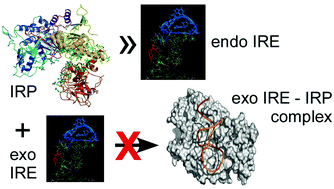当前位置:
X-MOL 学术
›
Metallomics
›
论文详情
Our official English website, www.x-mol.net, welcomes your
feedback! (Note: you will need to create a separate account there.)
The iron regulatory proteins are defective in repressing translation via exogenous 5′ iron responsive elements despite their relative abundance in leukemic cellular models
Metallomics ( IF 2.9 ) Pub Date : 2018-04-06 00:00:00 , DOI: 10.1039/c8mt00006a Emmanuel Pourcelot 1, 2, 3, 4, 5 , Marine Lénon 1, 2, 3, 4, 5 , Peggy Charbonnier 5, 6 , Fiona Louis 5, 6 , Pascal Mossuz 5, 7, 8, 9, 10 , Jean-Marc Moulis 1, 2, 3, 4, 5
Metallomics ( IF 2.9 ) Pub Date : 2018-04-06 00:00:00 , DOI: 10.1039/c8mt00006a Emmanuel Pourcelot 1, 2, 3, 4, 5 , Marine Lénon 1, 2, 3, 4, 5 , Peggy Charbonnier 5, 6 , Fiona Louis 5, 6 , Pascal Mossuz 5, 7, 8, 9, 10 , Jean-Marc Moulis 1, 2, 3, 4, 5
Affiliation

|
In animal cells the specific translational control of proteins contributing to iron homeostasis is mediated by the interaction between the Iron Regulatory Proteins (IRP1 and IRP2) and the Iron Responsive Elements (IRE) located in the untranslated regions (UTR) of regulated messengers, such as those encoding ferritin or the transferrin receptor. The absolute concentrations of the components of this regulatory system in hematopoietic cells and the ability of the endogenous IRP to regulate exogenous IRE have been measured. The IRP concentration is in the low μM (10−6 M) range, whereas the most abundant IRE-containing messenger RNA (mRNA), i.e. those of the ferritin subunits, do not exceed 100 nM (10−7 M). Most other IRP mRNA targets are around or below 1 nM. The distribution of the mRNA belonging to the cellular iron network is similar in human leukemic cell lines and in normal cord blood progenitors, with differences among the cellular models only associated with their different propensities to synthesize hemoglobin. Thus, the IRP regulator is in large excess over its presently identified regulated mRNA targets. Yet, despite this excess, endogenous IRP poorly represses translation of transfected luciferase cDNA engineered with a series of IRE sequences in the 5′ UTR. The cellular concentrations of the central hubs of the mammalian translational iron network will have to be included in the description of the proliferative phenotype of leukemic cells and in assessing any therapeutic action targeting iron provision.
中文翻译:

铁调节蛋白尽管在白血病细胞模型中相对丰富,但在通过外源性5'铁应答元件 抑制翻译方面存在缺陷
在动物细胞中,铁调节蛋白(IRP1和IRP2)与位于调节信使的非翻译区(UTR)中的铁反应元件(IRE)之间的相互作用介导了促进铁稳态的蛋白质的特异性翻译控制。那些编码铁蛋白或转铁蛋白受体的蛋白。已经测量了造血细胞中该调节系统的成分的绝对浓度和内源性IRP调节外源性IRE的能力。IRP浓度在低μM(10 -6 M)范围内,而最丰富的含IRE的信使RNA(mRNA),即铁蛋白亚基的信使RNA ,不超过100 nM(10 -7M)。大多数其他IRP mRNA靶标均在1 nM左右或以下。属于细胞铁网络的mRNA的分布在人类白血病细胞系和正常脐带血祖细胞中是相似的,细胞模型之间的差异仅与它们合成血红蛋白的不同倾向有关。因此,IRP调节剂与其目前鉴定的调节的mRNA靶标相比大大过量。然而,尽管有这种过量,内源性IRP在5'UTR中仍难以抑制用一系列IRE序列改造的转染萤光素酶cDNA的翻译。哺乳动物翻译铁网络中心枢纽的细胞浓度将必须包括在白血病细胞增殖表型的描述中,以及评估针对铁提供的任何治疗作用。
更新日期:2018-04-06
中文翻译:

铁调节蛋白尽管在白血病细胞模型中相对丰富,但在通过外源性5'铁应答元件 抑制翻译方面存在缺陷
在动物细胞中,铁调节蛋白(IRP1和IRP2)与位于调节信使的非翻译区(UTR)中的铁反应元件(IRE)之间的相互作用介导了促进铁稳态的蛋白质的特异性翻译控制。那些编码铁蛋白或转铁蛋白受体的蛋白。已经测量了造血细胞中该调节系统的成分的绝对浓度和内源性IRP调节外源性IRE的能力。IRP浓度在低μM(10 -6 M)范围内,而最丰富的含IRE的信使RNA(mRNA),即铁蛋白亚基的信使RNA ,不超过100 nM(10 -7M)。大多数其他IRP mRNA靶标均在1 nM左右或以下。属于细胞铁网络的mRNA的分布在人类白血病细胞系和正常脐带血祖细胞中是相似的,细胞模型之间的差异仅与它们合成血红蛋白的不同倾向有关。因此,IRP调节剂与其目前鉴定的调节的mRNA靶标相比大大过量。然而,尽管有这种过量,内源性IRP在5'UTR中仍难以抑制用一系列IRE序列改造的转染萤光素酶cDNA的翻译。哺乳动物翻译铁网络中心枢纽的细胞浓度将必须包括在白血病细胞增殖表型的描述中,以及评估针对铁提供的任何治疗作用。











































 京公网安备 11010802027423号
京公网安备 11010802027423号